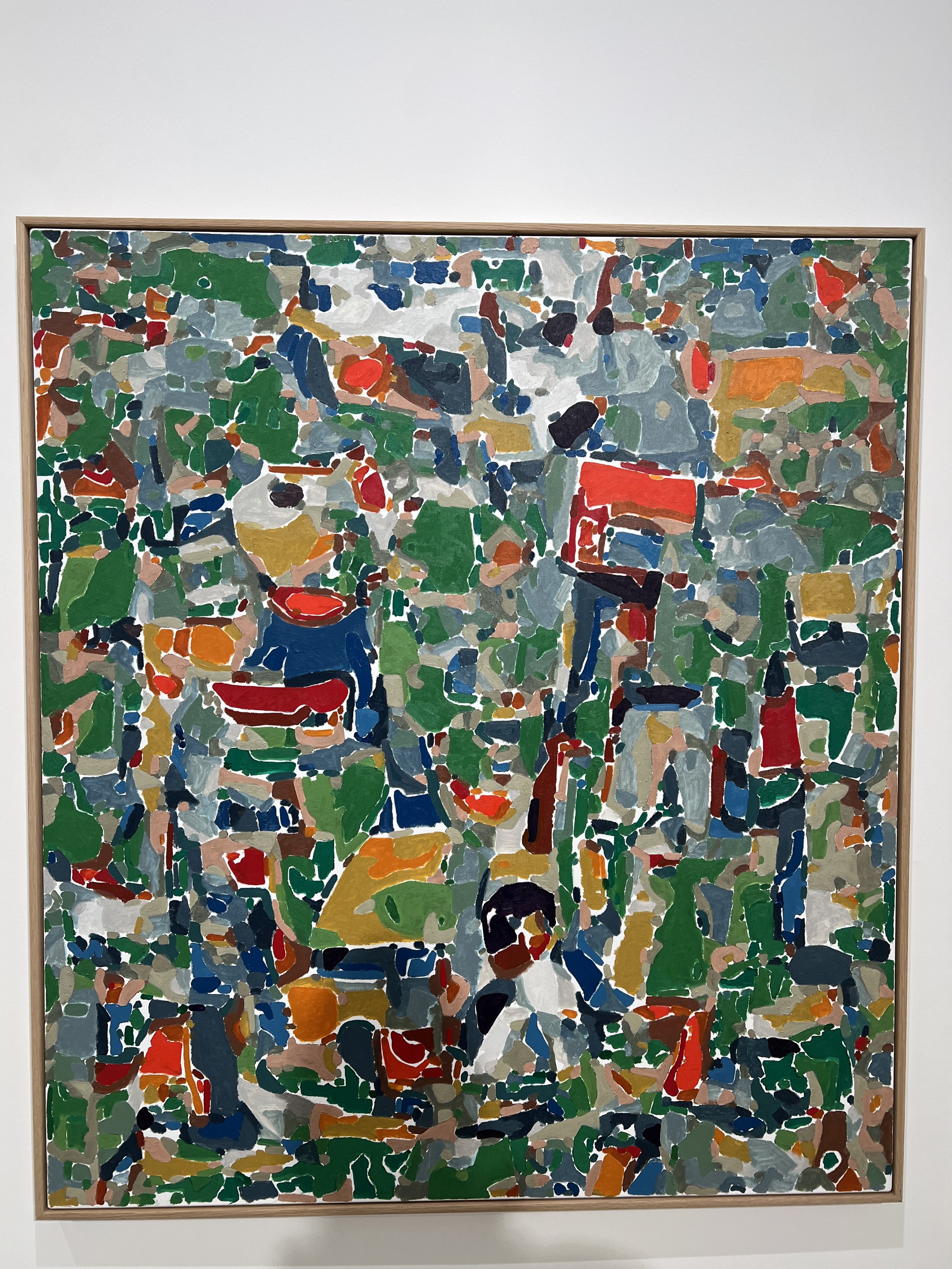Visit to the Gow Langford
Simon Ingram Talk - Colour Masses in the Fourth Dimension
Matter is not, in reality, what it appears to be…it is identical with energy and is only a manifestation of the movement of invisible and ponderable elements”1 (fig 1)
fig 1
Simon Ingram giving his talk
Artists talk with Q & A Saturday 26th August 2023
Ingram discussed his working methods and process for this show with AI generated images based on the work of Ukrainian artist Kazimir Malevich. Ingram’s response to the famous 1915 painting Black Square and Red Square otherwise known as Painterly Realism of a Boy with a Knapsack - Colour masses in the fourth dimension, has resulted in a collection of large as he calls it “stumpy rectangle” shaped canvases that actually work in pairs but are hung separately.
The idea of the fourth dimension which Ingram sees as a “world of invisible energy beyond the material world”, was a very popular idea at the time Malevich painted the Black Square and Red Square.2 Stemming from scientific discoveries of the time with X-Rays and Electromagnetic waves, this “ether of the space” was discussed and theorised by occultists and philosophers of the time.
This is just what I have been exploring in my essay “Colour as a Form of Thinking”, and in my current painting practice, especially with regard to the Victorian theosophists and Anthroposophists led by Rudolf Steiner. For many artists and thinkers of the time (see Mondrian exhibition in previous blog posts) the ‘ether‘ offered a model for vibratory thought transfer and for the interpretation of spirit and matter in ether/matter interactions.1
Conceptually this led onto the idea of the ‘fourth dimension’, a higher reality of which the third dimension was only a subset.
Ingram uses ‘Boy with a knapsack’ to prompt an open source machine learning tool to generate a series of compositions. In many of the paintings he explains he seeks to paint like a machine, creating his paint mixes first and then systematically copying the machine generated image.
The pair of smaller paintings that most interested me were worked on in a more painterly fashion mixes colour and responding as he went, the overall composition changing and emerging gradually and with more of the struggle shown. (fig 2,3 & 4)
fig 2
Untitles No. 2 (Painterly Realism of aBoy with a Knapsack - Colour Masses in the Fourth Dimension), 2023
oil on linen 900 x 800 mm
fig 3
Untitled No. 4 (Painterly Realism of a boy with a knapsack - Colour Masses in the fourth dimension, 2023
oil on canvas 1370 x 1220 mm
fig 4
Untitled No. 8
Painterly realism of a boy with a knapsack - colour masses in the fourth dimension, 2023
oil on linen 1370 x 1220mm
With each consequent set of pairs he said he tried to be more and more open, leaving spaces between the colour areas. I felt very connected to the fact he had used gouache in the past and tried to recreate some of that feeling of the material with oil paint. This is also similar to what I have been doing from my gouache en plain air sketch book studies to larger oil paintings.fig 5
fig 5
Sally Barron
Gouache of water colour paper 2023
Gow Langsford gallery says that Ingram refers to the paintings as compositions, rather than images, as they do not literally depict subject matter. Ingram’s compositions work as abstractions that also lend themselves to the interpretation of the image, and tap into ‘pareidolia’ - the human tendancy to impose meaningful interpretations onto nebulous stimulus, (for example seeing faces in clouds or tree bark, hearing music in random noises).
We fill in the spaces, interpreting what isn’t there as much as what is.
Ingram states, “I think good artists make their own set of rules and constraints, their own customs. This is an important part of painting.”
“This group of works can be seen as a journey through painting, a deep dive into what painting is. By reflecting on paintings plurality through machine learning and the tools of image replication, he takes the quasi-mystical idea of a fourth dimension and translates it into a poetic, contemporary form of painting.”3
When I return to the studio I experiment with art historical references of patterning and marks making from the European Art world 19th Century as my memory reference, (fig 6).
Fig 6, Sally Barron, oil on canvas, 450 x 1200 mm
work derived from Harlequin grid and faded colour
Footnotes
1 Camille Flammarion, Les Forces naturelles inconnues, 1907.
2 Linda Dalrymple Henderson, “Abstraction, the Ether, and the Fourth Dimension: Kandinsky, Mondrian and Malevich in Context”. Interalia Magazine, November 2020.
3 Gow Landsford gallery Simon Ingram exhibition introduction Colour Masses in the Fourth Dimension 2023
Inspired by the exhibition I try and ‘AI’ my current painting, (fig 8).
fig 8
Computer generated image of my WIP 2023







